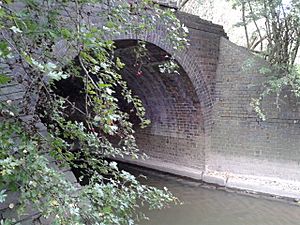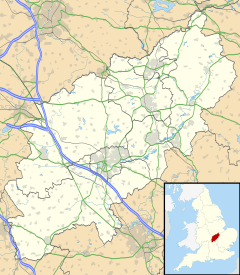Barton Seagrave facts for kids
Quick facts for kids Barton Seagrave |
|
|---|---|
 St Botolph's parish church |
|
| Population | 4,418 (2011 Census) |
| OS grid reference | SP890765 |
| • London | 81 miles (130 km) |
| District |
|
| Shire county | |
| Region | |
| Country | England |
| Sovereign state | United Kingdom |
| Post town | Kettering |
| Postcode district | NN15 |
| Dialling code | 01536 |
| Police | Northamptonshire |
| Fire | Northamptonshire |
| Ambulance | East Midlands |
| EU Parliament | East Midlands |
| UK Parliament |
|
Barton Seagrave is a big village in North Northamptonshire, England. It's about 1.5 miles south-east of the town of Kettering. The older part of the village is famous for its beautiful buildings and a church built in the Norman style.
The name 'Barton' means 'barley farm'. The 'Seagrave' part was added in 1220. This was when the land became owned by a family called Seagrave.
| Top - 0-9 A B C D E F G H I J K L M N O P Q R S T U V W X Y Z |
Village Life: Barton Seagrave Facts
How Many People Live Here?
In 2011, a count of the population showed 4,418 people lived in Barton Seagrave. They lived in 1,843 homes.
Getting Around: Transport Links
Barton Seagrave has good transport connections. The A6 road goes through the village. This road connects London and Leicester. It also meets the A14 road nearby. The A14 helps you get to the M1 motorway. This means you can easily reach places like Huntingdon, Felixstowe, and London.
The Midland Main Line railway runs close to the village. The nearest train station is Kettering railway station. It opened in 1857. East Midlands Railway runs trains from here. You can travel to London, Sheffield, Corby, and Derby.
Long ago, the village had a train line to Cambridge. This line closed in 1961. Today, part of the old railway path is a walking trail.

Who Runs the Village?
Barton Seagrave has its own local government. This includes the Barton Seagrave Parish Council. They meet at the village hall on Bertone Road. This hall was finished in 2017.
The village has been around for a very long time. It became a separate parish again in 2002. In 2021, it became part of the larger North Northamptonshire Council.
What Can You Find in Barton Seagrave?
The village has many useful places. There's a shop on Gotch Road for everyday needs. You can also find a Post Office on St Botolph's Road. A petrol station is located near the A6 road.
The village also has a Community Centre on Castle Way. The Masque Theatre is here too. A new village hall opened in 2017.
The church, St Botolph's, is very active. It's next to the war memorial on the village green. The church offers groups for all ages. These include groups for young children, teens, and seniors. They also hold many social events.
There is one pub in the village called The Stirrup Cup. It's on Woodlands Avenue. They serve different drinks and have a quiz night regularly.
Nature and Green Spaces
Barton Seagrave is home to the Castle Fields Wildlife Trust site. The Wicksteed Trust manages this area. It's a great place for plants like Meadowsweet. A path goes through this area to the arboretum at Wicksteed Park. Sheep often graze here in the summer.
There's also a small woodland area called Wallis Spinney. It's part of the Ise Valley. You can reach it from Belvoir Drive. This woodland is very old. It has mostly ash and field maple trees. It's now being looked after. There are paths and signs for visitors. The woodland is named after a local farmer, Samuel Wallis. It used to belong to Wicksteed Park. Many trees were likely planted in the 1600s.
Schools in the Village
Barton Seagrave has three schools, with a fourth one being built. The Latimer Arts College is a secondary school. It focuses on performing arts. It has a theatre and dance studios. Hanwood Park School is a new secondary school. It is planned to open in 2024.
Barton Seagrave Primary School is nearby. It has grown bigger recently. Hayfield's Cross Church of England School is another primary school. It opened in 2015.
Village Growth: New Developments
The village is growing. Many new homes have been built. These new areas are expanding the village. More homes are planned for the future. These plans include new primary schools, a secondary school, and local shops. There will also be doctors' surgeries.
Important Buildings in Barton Seagrave
The Old Church
Barton Seagrave has one of the oldest churches in Kettering. Parts of it were built between 1120 and 1130 AD. Most of the church is from the 1200s. It is the Norman Church of England parish church of Saint Botolph. People often call it 'St Bot's'.
Inside the church, you can see old memorials. One is for Jane Floyde, who died in 1616. There are also memorials to the Bridges family. The Bridges family used to live at Barton Seagrave Hall. The Barton Seagrave War Memorial is in the church grounds.
The Rectory Building
This building was built around 1700. The south side was rebuilt in 1806. Today, it is called 'Church House'. It offers community facilities and church offices.
Barton Seagrave Castle Site
South-west of the village centre, you can find the site of Barton Seagrave Castle. It was built in the early 1300s. But it became a ruin after 1433. The castle was surrounded by a moat. Another moat is north of the castle site. You can still see these moats today.
Barton Seagrave Hall and Wicksteed Park
Barton Seagrave Hall was first built in 1550. The Bridges family bought it in 1665. John Bridges (1666–1742) inherited the house. He was a historian and a Fellow of the Royal Society. Later, his brother William owned it.
The house was owned by different families over the years. Lady Mary Isabella Hood-Tibbits lived there until 1904. Then, Charles Wicksteed bought the house. He created Wicksteed Park on the land around it. After he died, the house and park went to the Wicksteed Village Trust.
The Hall has been used for many things. It was a hotel, then a nursing home. For a while, it housed part of the NHS. It also became an arts centre. Now, it is home to the Vines Restaurant and the Barton Hall Hotel. You can also rent it for weddings and other events.
The house has two floors. It is made of limestone and has a roof of Collyweston slates. The front faces south. An old part of the building is at the east end. The Orangery is a very important historical building.
Famous People from Barton Seagrave
Rear Admiral Horace Hood once lived in Barton Hall. He died in 1916 during a big sea battle. His name is on the Barton Seagrave War Memorial.
The famous opera singer Elizabeth Harwood was born in the village in 1938.
Other notable people from the village include John Bridges, a writer about places, and his brother Charles, a painter.
Images for kids
See also
 In Spanish: Barton Seagrave para niños
In Spanish: Barton Seagrave para niños



